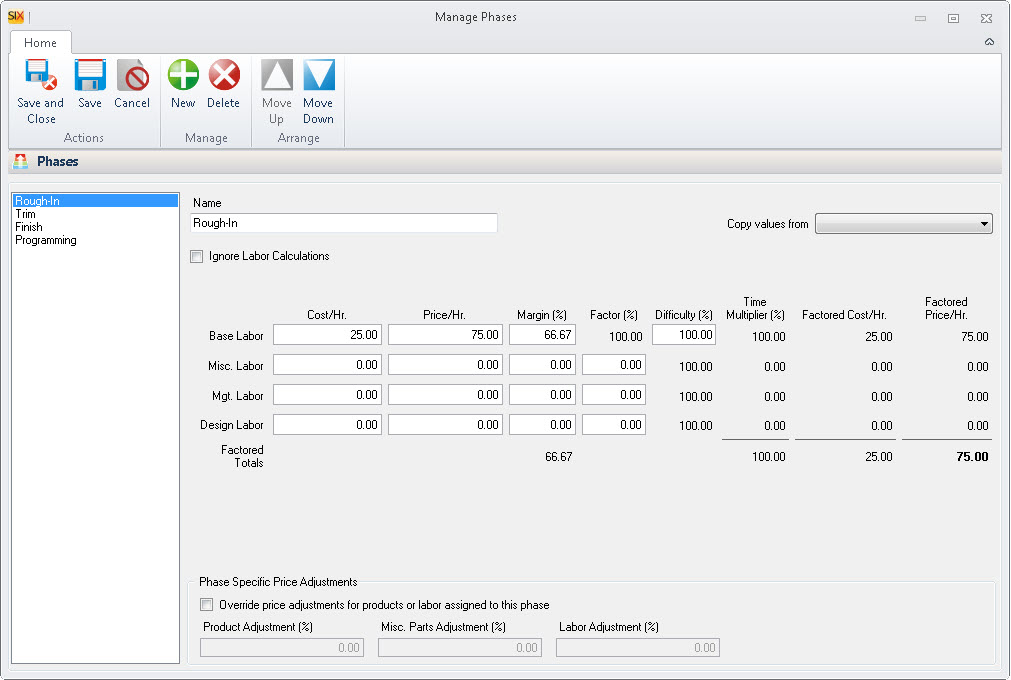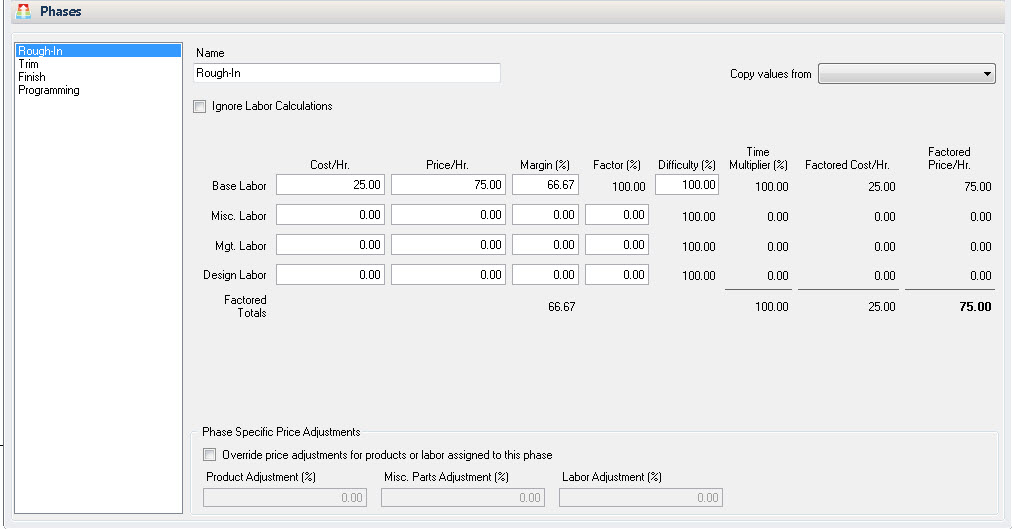Phases
Setting
Here you can add/edit/delete Phases.

The Manage Phases form lists all of the Phases you have in your Catalog.
What are the benefits of this setting?
Allows you to identify the Phase of the project that Items are assigned to within a project, as well as charge for labor within a project on a per/product basis.
When to use this setting?
If you want to identify the Phase of a project when a Product/Labor Item is being installed. This is handy for filtering/grouping reports. This is also one way to charge for labor on a per/product basis. You set your labor rates per Phase, and then on Products you assign them a Phase and Unit Labor Hours value.
Details
Remarks
See Labor Considerations to see your options for charging for labor in SIX Projects and Service Orders.
Manage

You can add new Phases or edit existing ones.
You can delete Phases here. When you delete a Phase, Items in your Catalog assigned to this Phase will no longer be assigned this Phase.
If you edit a Phase name, all products in your Catalog assigned this Phase will be updated with the new Phase name.
You can order your Phases using the Move Up/Down buttons.
Fields
Each Phase is broken down into four sections: Base Labor, Misc. Labor, Mgt. Labor and Design Labor. There are eight columns: Cost/Hr, Price/Hr, Margin (%), Factor (%), Difficulty (%), Time Multiplier (%), Factored Cost/Hr, and Factored Price/Hr.
| Field | Description |
|---|---|
| Cost/Hr: | How much labor costs you per hour |
| Price/Hr: | How much you charge per hour of labor |
| Margin (%): | The margin between Cost/Hr and Price/Hr |
| Factor (%): | What percentage of each Base Labor hour you are charging the client. This number is always 100% for the Base Labor but you will most likely vary the Misc., Mgt., and Design percentages. This will affect the number of hours used in calculations. For example a Design Labor factor of 25% would mean that you would include .25 hrs (15 minutes) of Design Labor for each hour of Base Labor (Install Labor). |
| Difficulty (%) | This field is a multiplier for hours and it affects the Base and Misc. hours only. This number should be set to 100% by default but can be changed on a per project basis if you wish to increase the number of hours charged for Base and Misc. Labor. For example, if you change this number to 200% for the Rough-In Phase within a project, all products assigned to the Rough-In Phase would will double the existing hours. |
| Time Multiplier (%) | These numbers show the details of what is being multiplied. |
| Factored Cost/Hr: | Displays your Cost/Hr based on the number you enter for the Factor(%) |
| Factored Price/Hr: | This field cannot be edited. It is your Price/Hr based on the number you enter for the Factor(%) |
Ignore Labor Calculations
This option to have no labor calculations compute for a particular Phase. You might use this option within a Project, for example, where you were not charging labor and only want to charge a client for the equipment within a particular Phase.
Phase Specific Adjustments

This section for each allows you to set a Product Adjustment %, Misc Parts Adjustment %, and/or a Labor Adjustment % on a per Phase basis. When you check the Override Project Defaults for this Phase box, these values will override the Product Adjustment %, Misc Parts Adjustment %, and Labor Adjustment % settings under Price Adjustments Settings. Using these price adjustment settings on a per Phase basis gives you more control and accuracy than if you charge a percentage all products in a project.
Within the Project Editor
There are additional functions on the Manage Phases form within the Project Editor. To open this form, click the Settings tab then the Phases button:
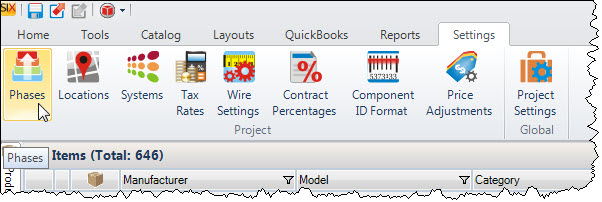
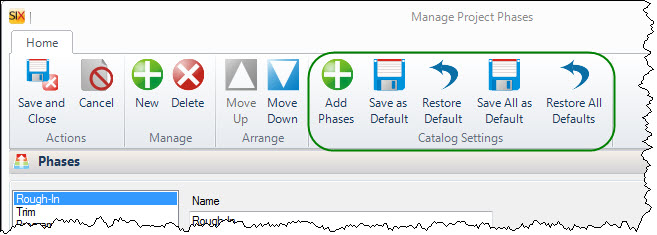
Within a Project, you can adjust your Phases specifically for that Project. However, if you want the changes you make within a Project to be saved to your Catalog for all future Projects, you can. The [Save as Default] button will save the currently selected Phase to the Catalog while the [Save All as Default] button will save all Phases. The opposite of this is the [Restore Default] and [Restore All Defaults] buttons. These buttons will populate the Phase settings within the Project with whatever is in the Catalog.
These functions are most commonly used by new users who create their first Project before setting up their Phases and then want the changes they make in the Control Panel to apply to their existing Project(s).
The [Add Phases] button can be used if you created a Project and then created new Phases in your Catalog via the Control Panel.
When you click this button, a form will open showing you the Phases that are not already in the Project. You can select the ones you want then click the [Add] button:
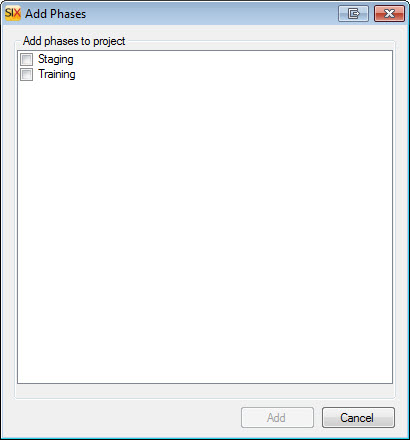
Site Map for Administration
- Administrator Guide
- Environment
- Hardware/Software Requirements
- Installing SIX
- Setup
- Create Users
- Backup/Restore
- © Copyright 2024 D-Tools

